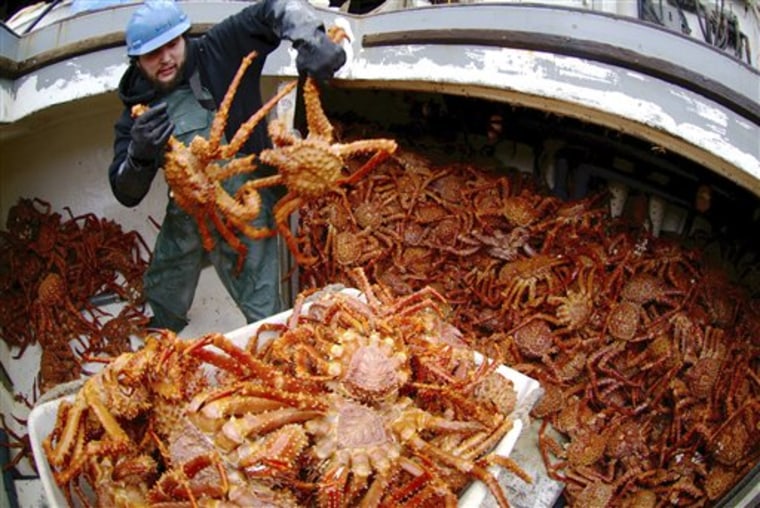You’ve heard of Alaska King Crab and Maine Lobster. Why not Massachusetts Mackerel or maybe Cape Cod Cod?
States are increasingly looking to hook consumers by branding their local seafood specialties, both to help reel in revenue and to give a boost to commercial fishermen struggling with declining stocks and tighter regulations.
In Louisiana, officials are creating a top-of-the-catch program for shrimp and oysters. Rhode Island is distributing logo-emblazoned quahog carriers.
And in Massachusetts, where a carving of the state’s “Sacred Cod” hangs in the House chambers, lawmakers are weighing whether to create a branding program that “embraces the historic roots of fishing in the commonwealth.” A hearing is scheduled on the bill Thursday.
“Folks see a long tradition of fishing in Massachusetts,” said the bill’s sponsor, state Rep. James Cantwell, a Democrat from the coastal community of Marshfield. “That is something that would bring value to our seafood as it gets marketed across the country.”
For those who ply the seas for their daily bread, any help is welcomed.
“In the marketplace there’s a lot of confusion these days about where things come from and how fresh they are,” said Edward Barrett, a commercial fisherman and president of the Massachusetts Fisherman’s Partnership, who stressed conservation and clean-water efforts in Massachusetts.
“All these are good things that need to be clear in the consumer’s mind,” he said.
Several states have seized on the idea of ratcheting up the culinary cachet of their local fish.
In Louisiana, which produces about 130 million pounds of shrimp annually, officials hope to boost prices by branding the cream of the crop — about 20 million to 30 million pounds — with the help of a new quality-control program.
Shrimpers who agree to the stricter oversight will have their catch branded “Certified Louisiana Shrimp.” A ticket will follow each catch from boat to processing house. The state hopes to expand the program, designed to appeal to high-end consumers, to crabs and other fish.
“We’ve got to create a different market for our products,” said Harlon Pearce, chairman of Louisiana Seafood Promotion and Marketing Board. “It’s to help the fishermen first and foremost.”
Other states are trying less intensive branding efforts.
Rhode Island distributes special purple mesh bags with a distinctive logo for fisherman to store their quahogs, the local delicacy, on the trip to the distributor.
Florida has a “Go Native!” campaign to encourage restaurants to serve locally harvested fish. This year the state has been trying to raise the profile of stone crabs and spiny lobsters.
The Maine Lobster Promotion Council distributes “Certified Maine Lobster” tags to lobstermen to guarantee people shelling out big bucks for Maine lobster in restaurants across the country aren’t being served “impostor lobsters” from other states or Canada.
North Carolina has taken its local branding efforts down to a county level, said Barry Nash, a seafood technology and marketing specialist associated with North Carolina State University. The Carteret Catch program, named after the North Carolina county, educates residents both about the availability of local seafood and the fishermen who work to harvest the catch.
“We are really trying to personalize the product to let people know that there are a lot of people who are making their living off commercial fishing,” Nash said.
When it comes to seafood branding, however, few states can match Alaska, and with good reason. Alaska is home to one of the largest food fisheries in the world, harvests over half the nation’s wild caught seafood, and has honed its branding campaign over three decades.
It launched the successful Alaska Seafood brand — a brand that it applies to any number of seafood, from Alaska Salmon to Alaska King Crab. The state has also trademarked slogans for its catch, including “Wild, Natural & Sustainable.”
“When consumers see seafood branded ’Alaska’ they are more inclined to order it in a restaurant,” said Laura Fleming, spokeswoman for the Alaska Seafood Marketing Institute.
Fleming said the goal of the marketing and branding campaign is simple. With a finite natural resource like fish, the only way to increase value is to drive up demand.
“It takes a sustained effort and sustained financing,” she said. “It’s a big world out there and you’re trying to make a dent.”
For John Haviland, a Massachusetts fisherman with 34 years of commercial experience, the success of any program will be measured in how much it helps fishermen.
“It’s cool that it’s branded and everyone says ’I have to have a Massachusetts lobster, they’re the best’ but how is that going to then come out and help the poor commercial fisherman?” said Haviland. “How will you then create a better price?”
